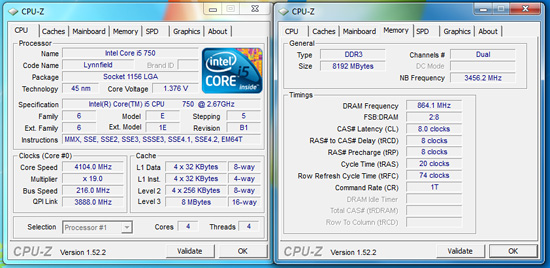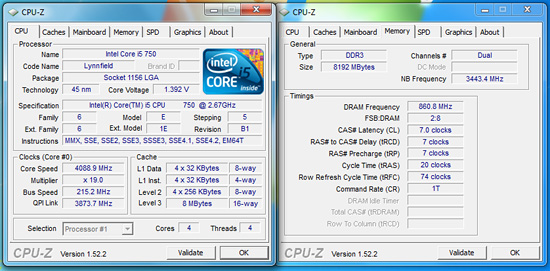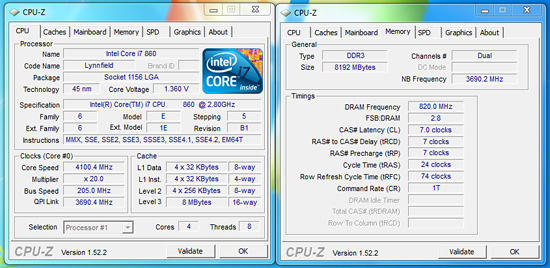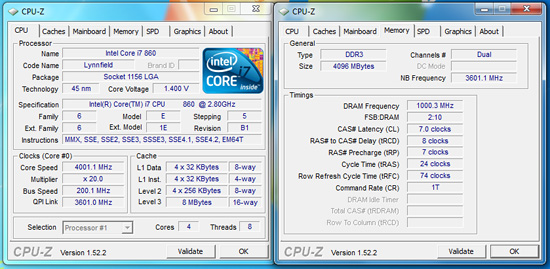Budget Micro-ATX P55 Faceoff: Gigabyte GA-P55M-UD2 and ASRock P55M Pro
by Gary Key on October 5, 2009 12:30 PM EST- Posted in
- Motherboards
Overclocking
If you are on a strict budget but still want a P55 motherboard with a full feature set that offers solid overclocking abilities, the ASRock P55M Pro is a very good choice.
Core i5/750 8GB Results

Our maximum stable overclock on air-cooling with the Core i5/750 resulted in a 4.1GHz clock speed at a respectable 216MHz Bclk with a variety of 8GB DDR3-2000+ kits. The primary voltages settings were 1.3625V VCore, 1.36V VTT, 1.80V PLL, and 1.64V VDimm. The VCore setting is deceiving. We had to run the board with Load Line Calibration (Vdrop off) enabled for stability. This was with setting the voltage manually to 1.3625V or with the Overdrive Offset enabled with +0.1625V.
This meant the VCore would rise to 1.384V~1.392V during load conditions. It was either this or run the processor at 1.425Vand accept Vdroop of 0.05V. Also, we had to relax memory timings to DDR3-1728 at 8-8-8-20 1T settings. VDimm would have to be increased to 1.71V (the next step from 1.64V) in order to run C7 settings on this board.


We could improve memory timings or speed with the Bclk set to 215 and dropping our CPU multiplier to 19, but that required a VCore increase to 1.375V as we left VTT at 1.36V along with enabling Vdrop in the BIOS. Memory had to be increased to 1.71V for C7 operation and PLL remained at 1.80V. We could run the memory at DDR3-2152 at 9-9-9-27 2T but VTT had to be increased to the next step at 1.42V and PLL to 1.94V. Performance was not measurably different from our 19x206 setting in application testing, but CPU temperatures were up 3C. Even though these settings passed our stability test suite, we just felt like the trade off in increased voltages was not worth some very minor memory performance gains.
Core i7/860 8GB Results

Our i7/860 fared better clocking wise than the i5/750, but we could not match the 21x205 speeds generated with the Gigabyte board without raising VCore to 1.425V. We ended up at a perfectly stable 20x205 setting resulting in a 4.1GHz clock speed with 8GB at DDR3-1740 at 7-7-7-24 1T timings. However, our voltage settings were lower due to the decreased clock/memory speeds.
VTT is set to 1.36V, PLL at 1.94V, VDimm at 1.64V, and VCore at 1.350V with the Overdrive Offset/VDrop enabled. Under load conditions VCore was +.015V~+.02V with Vdrop enabled and -.055V~-.06V with it disabled. Our Core i7/870 clocks matched these exactly.
Core i7/860 4GB DDR3-2400 Results

ASRock advertised DDR3-2400 speeds so we decided to verify their claim. Unfortunately, the board had serious problem running our OCZ DDR3-2400 Blade kit at 2400 with the stock 9-10-9-24 1T settings on 1.71V. We just could not dial in stability at that memory speed. We had to settle for DDR3-2000 7-8-7-24 1T timings at 1.64V. Of course, those memory speeds is more than fast enough for application usage and let’s face it, nobody will be buying this board thinking they are going to break world records.
Thoughts
The overclocking results are solid and certainly 4.1GHz speeds are fast enough for most. Let’s face it; if you have to have the best possible OC performance, then the Gigabyte UD2 board is simply better. We have no concerns recommending the ASRock board for 24/7 overclocking use. When it is overclocked, the board is very stable. As a bonus, it had no problems doing an S3 resume with the Bclk set to 215.
In regards to voltage regulation, ASRock follows Intel’s guidelines exactly. This has advantages as the processor is always running at specifications when it comes to Vdrop and Vdroop, but the disadvantage is that one has to really take time to tune the board to get the most out of it. The board was really designed to get you to about 90% of your component’s capabilities and that is it. Trying to tune another 5% performance improvement was possible, but very time consuming and frustrating to be honest.
In most cases I would not use the word frustrating, but compared to the Gigabyte UD2 board, that next five percent in tuning consumed about five times as much time on the ASRock board and we still did not match the speeds on the Gigabyte board. Granted, we are talking about numbers that look really good in screenshots and yes, application performance like encoding and file compression will show a small improvement. However, one has to ask if it is worth it.
The end story is that we would rather implement a practical overclock around 3.8GHz with the i7/860 or i5/750 at 1.275V than push to speeds around 4.1GHz~4.3GHz that require more expensive memory kits and cooling. In that context, the ASRock board is more than capable for most overclocking duties.
















55 Comments
View All Comments
Sunburn74 - Monday, October 5, 2009 - link
Thanks.Which board? I searched the thoughts section and don't see any mention of sleep :(
I just know its a huge problem with gigabyte boards, pretty much every p45- and a good number of the x58 boards mysteriosly can't s3 sleep with significant overclocks in place and its something I'm seriously going to explore before my next mobo purchase.
Ryun - Monday, October 5, 2009 - link
I purchased and Asrock 760g, which is a great little motherboard, yet it does not support S3 state (standby mode). I have an email from Asrock's (surprisingly quick-response) tech support saying that none of their boards officially support S3 state and to use their Instant Boot technology instead.Did the Asrock motherboard you tested allow you to go into S3 state/standby mode? I really like Asrock's boards but the lack of standby is a deal breaker for me.
Gary Key - Monday, October 5, 2009 - link
S3 is fully supported on the ASRock board. In the power consumption section I did note what needed to be enabled for it work. Also, this was probably in the wrong spot, but in the OC section I briefly mentioned that the board had no problems resuming from S3 with the Bclk set to 215. I can understand why ASRock wants you to use Instant Boot, but S3 operation is just fine, even when overclocked.Ryun - Monday, October 5, 2009 - link
Ah, looks like I missed that part. Many thanks for pointing that out. Sadly though, I don't have those BIOS options on the 760g board I have but perhaps I can tinker a bit more.n7 - Monday, October 5, 2009 - link
Just wanted to say a massively huge thank you for testing with 8 GB!It's extremely encouraging to see, as the large majority of reviewers do not bother testing with all slots populated.
Thanx again.
vlado08 - Monday, October 5, 2009 - link
Which board has the quickest Power On Self Test?With fast CPU's and SSD I expect fast booting!
Now I have a Gigabyte board (P965 DS4) and when the Sata is in AHCI mode POST is quite long.
I hope that in future articles you will include this information.
MadMan007 - Monday, October 5, 2009 - link
S3 is your friend. Really, who boots their computer every time any more?strikeback03 - Monday, October 5, 2009 - link
I usually do, since I dual boot and won't necessarily know which OS I need the day before.Gary Key - Monday, October 5, 2009 - link
Cold Boot - Quick Boot turned off in BIOS - AHCI enabled, External Hard Drive attached via IEEE 1394a, LAN attached to our Promise NAS via a Gigabit Switch.Time reported is from the time we turn on the board until Win7 has correctly installed the network stack. So this is the full POST and OS is usable process that is being timed.
ASRock - 44.7 seconds
Gigabyte - 53.2 seconds
I have the information since we run this for every board, just did not know if anyone would care to see it. ;)
vlado08 - Tuesday, October 6, 2009 - link
Thanks GaryBut I was interested in time from pushing the power on switch until the begining of the OS loading. I think that there might be difference between boards depending on their BIOS.
Time from begining of the OS loading until fully functional OS depends on the computing power ot the CPU and the speed of the HDD (SSD) and not on the design of the board.
And because you (we) want to distinguish between the boards I thought that this might be one of the criterion.